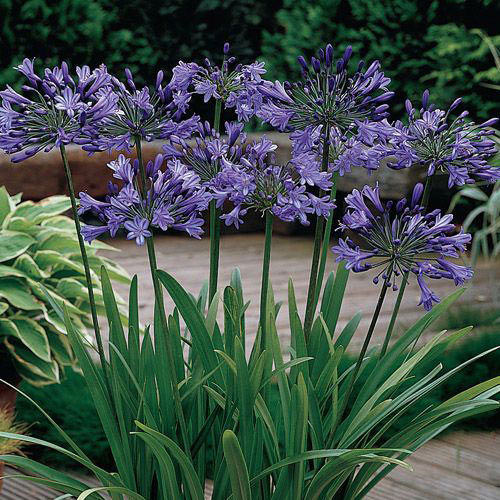Agapanthus Varieties: Selecting the very best for Your Landscape
Agapanthus Varieties: Selecting the very best for Your Landscape
Blog Article
Mastering the Art of Agapanthus Care: Necessary Actions for Healthy Development and Vivid Blooms
In the realm of horticulture, the farming of agapanthus stands as a fulfilling endeavor for those that look for to support these classy flowering plants. From picking the best selection to mastering trimming methods, the trip towards cultivating flourishing agapanthus plants is diverse and holds the crucial to unlocking the full capacity of these agricultural gems.

Picking the Right Agapanthus Variety

When choosing the appropriate Agapanthus selection for your garden, consider elements such as climate suitability, bloom shade, and growth routine. Additionally, take into consideration the climate in your area to guarantee the Agapanthus range you pick can flourish in your particular problems. Comprehending the growth routine of various Agapanthus ranges is essential for correct positioning within your garden.
Suitable Growing Conditions
Taking into consideration the optimal environmental needs is vital for effective Agapanthus cultivation. Agapanthus thrives in well-draining soil with a somewhat acidic to neutral pH level. When growing, pick an area that receives full sunshine to partial color. In hotter environments, providing some afternoon color can prevent scorching of the leaves. Agapanthus plants are sensitive to chilly temperatures and must be safeguarded from frost throughout winter months.
To ensure healthy growth and dynamic blooms, plant Agapanthus bulbs at a deepness of concerning 2-4 inches and room them 8-12 inches apart. Mulching around the base of the plants aids maintain wetness and reduces weed growth.
Watering and Fertilizing Tips
Maintaining proper dampness degrees and supplying necessary nutrients are key elements in the treatment program for Agapanthus plants. It is vital to strike a balance when it comes to sprinkling Agapanthus. These plants like consistently wet soil but are susceptible to root rot if overwatered. Throughout the expanding season, water deeply once a week, making certain the dirt is well-draining to avoid waterlogging. In hotter climates or during durations of dry spell, more constant watering might be needed to keep the dirt equally damp. Nonetheless, minimize watering in the winter months to protect against water logged problems.
Feeding Agapanthus is necessary for promoting healthy growth and respected blossoms. Apply a balanced fertilizer, such as a 10-10-10 formula, in the very early springtime as brand-new development emerges. By adhering to these watering and feeding suggestions, you can ensure your Agapanthus plants thrive and generate dynamic, durable blooms.
Trimming Techniques for Agapanthus
Pruning Agapanthus plants at the proper times and with appropriate strategies is essential for maintaining their wellness and promoting optimal growth and flowering. The optimal time to trim Agapanthus remains in late winter or early spring before new growth emerges. Start by eliminating any kind of yellowing or dead fallen leaves near the base of the plant. Cut them as short link as feasible without damaging the emerging shoots.
Deadheading spent flowers can also reroute the plant's energy right into producing even more blooms rather than establishing seeds. If you want to collect seeds for proliferation, leave some flowers to fully grown and dry on the plant.
Remember to use tidy, sharp tools to make accurate cuts and lower the danger of introducing conditions. Agapanthus. Regular trimming will help maintain your Agapanthus looking healthy and cool while guaranteeing an abundant display screen of beautiful flowers
Dealing With Typical Insects and Conditions
After ensuring proper trimming strategies for Agapanthus, it is important to deal with common bugs and conditions that can impact the wellness and vitality of these plants. Agapanthus plants are normally durable however can still succumb to particular concerns. One common parasite that affects Agapanthus is the Agapanthus gall midge. This small, orange fly lays its eggs in the vegetation, causing distorted development and flower buds that fall short to open. To combat this pest, trim and ruin any damaged plant components and think about using insecticidal soap.
An additional usual problem is fungal fallen leave spot, which offers as dark sores on the leaves. To stop fungal diseases, make sure excellent air circulation around the plants, avoid overhanging watering, and get rid of any type of infected fallen leaves without delay. Furthermore, Agapanthus plants can experience root rot Web Site if they are grown in inadequately draining pipes dirt. To avoid this, plant Agapanthus in well-draining dirt and avoid overwatering. By being cautious and taking punctual action versus bugs and illness, you can help your Agapanthus plants thrive and create vivid blooms.

Conclusion
In verdict, grasping the art of agapanthus care entails selecting the appropriate variety, offering optimal growing problems, appropriate watering and feeding, proper pruning methods, and dealing with usual bugs and diseases. By following these vital steps, you can guarantee healthy development and vivid blossoms for your agapanthus plants. Keep in mind to consistently why not check here monitor and keep your plants to promote their overall wellness and durability.
To guarantee healthy development and vibrant blossoms, plant Agapanthus light bulbs at a depth of concerning 2-4 inches and room them 8-12 inches apart. By following these watering and feeding tips, you can guarantee your Agapanthus plants prosper and produce lively, lasting blooms.
One usual pest that affects Agapanthus is the Agapanthus gall midge. In addition, Agapanthus plants can experience from root rot if they are grown in poorly draining pipes dirt. By following these essential actions, you can guarantee healthy growth and vibrant blossoms for your agapanthus plants.
Report this page